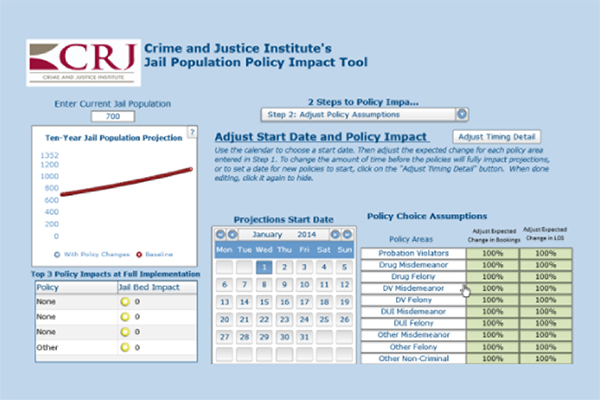
BOSTON, Mass. — The Crime and Justice Institute (CJI) at Community Resources for Justice is pleased to introduce a new tool that criminal justice agencies can use to forecast jail populations based on local data.
The tool, developed with economist Mike Wilson, uses a jurisdiction’s own historical jail data and county population projections to dynamically estimate long term jail impact. Users may then select up to ten policy areas to create individual population effects.
CJI continues to make criminal and juvenile justice systems more efficient and cost effective by meeting the needs of its clients through evidence-based and results-driven assistance. CJI’s latest contribution is the Jail Population Policy Impact Tool©. Michael Wilson, an economist partnering with CJI, worked to develop a model that criminal justice agencies can use to forecast jail populations based on local data and user-selected dynamic factors.
The resulting Jail Population Policy Impact Tool uses a jurisdiction’s own historical jail data and county population projections to dynamically estimate long term jail impact. Jurisdictions may then select up to ten policy areas to create individual population effects.
Critical inputs for the population projections include:
- Estimated or projected growth rates of jail bookings,
- Average length of stay in jail,
- Size of “at risk” population as defined by the jurisdiction, and
- Estimated impact of up to ten different policy areas, with respect to changes in size and average length of stay.
WHY IS THIS TOOL UNIQUE?
The Jail Population Policy Impact Tool allows users to make their own assumptions about growth factors using historical jail data and population forecast data. Users are then able to update the assumptions and underlying historical jail populations at any time. While other jail models are static and can quickly become outdated, this model can be adjusted based on changing policies and population characteristics.
One of the significant benefits of this tool is its ability to calculate the estimated impact of up to ten policy choices on the long term jail population. Additionally, the user can select the timing of policy changes, permitting a staggering of effects that is more accurate to real-life implementation. Policy levers can target specific offending populations, allowing the user to make adjustments to the size of the population and the length of stay in the jail. For example, a jurisdiction could target probation violators for a new jail alternative program, reducing the population in jail and their length of stay. The local probation department can identify the capacity of the new alternative program, and the model will automatically calculate the impact of these changes based upon the assumptions. The new program’s population effect is shown over a ten year period and visually depicts the results in a table and graph format.
Jail population management is an important fiscal consideration in local jurisdictions throughout the country. The Jail Population Policy Impact Tool, developed by the Crime and Justice Institute, can provide local jail and county managers with valuable insight into the future costs of current policies and projected costs or savings from future policy changes. With the Jail Population Policy Impact Tool, policy makers, budget writers and criminal justice leaders can make data-driven decisions that are more accurate and cost-effective.
For More Information
If you would like permission to use the Jail Population Policy Impact Tool or more information, please contact Michael Kane at the Crime and Justice Institute at Community Resources for Justice at mkane@crj.org or at 617-482-2520 x124.Copyright © 2014 by Crime and Justice Institute at Community Resources for Justice